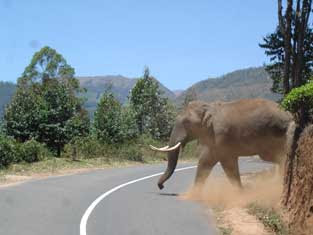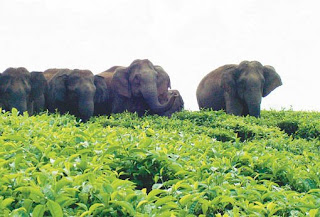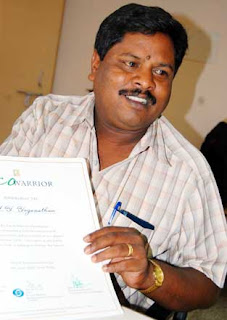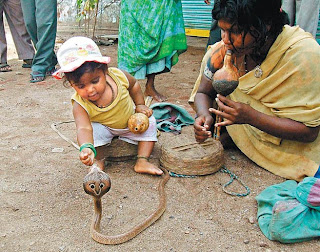News: - (News India):
SALEM: In a novel campaign, farmers and environmentalists who have joined hands to fight an iron ore mining project at Kanchamalai in Salem, filed 530 applications under the Right to Information Act with the Department of Forests en masse on Tuesday.
Over 700 farmers with their families converged on the District Forest Office on Tuesday. Catching the officials unaware, they filed individual applications, seeking details of the proposed project to mine iron ore from the pristine surroundings of the Kanchamalai hills by a joint venture company floated by Tamil Nadu Industrial Minerals Corporation Ltd (TIMCO) and the private steel major Jindals.
The magnetite ore to be mined is to be used for manufacturing iron ingots at the Mecheri plant of the South India Iron and Steel Co Ltd (SISCOL), a Lakshmi Mills-TN government JV taken over by the Jindals.
Officials initially said only one application would be received. But the people insisted that every family affected by the project wanted to know to what extent the project would impact their lives.
The applications contained five questions pertinent to the project and the Forest Department’s response to the forest clearance petitions filed by the company, besides the department’s EPA (Environmental Impact Assessment) documents.
According to official sources,
TIMCO and SISCOL joint venture wants 1,000 acres of mineral-rich hills in two places in Tamil Nadu.
While 638 acres is sought at Kanchamalai, revered for the indigenous medical practitioners and rich herbs, 330 acres has been asked for at Tiruvannamalai.
Around 90,000 trees at Kanchamalai and 2 lakh trees in Tiruvannamalai (
recently collector of Tiruvannamalai wanted to plant more trees) will be felled once the project is cleared by the Forest department.
Indicating that the Forest department has given its green signal for the project (which it rejected earlier), Forest department officials said, “Things are no more in our hands but with the Supreme Court, which sent its Empowered Committee on May 29, 30 to Kanchamalai to give its report.”
Some one has to take initiave to stop deterioating the already depleted small forest resources in India.
Effects of Iron Ore Mining:
Ecotoxicology and Environmental Safety
Volume 46, Issue 2, June 2000, Pages 218-224
Iron Ore Mines Leachate Potential for Oxyradical Production
D. Hamoutene, A. Rahimtula and J. Payne
Biochemistry Department, Memorial University of Newfoundland, St. John's, Newfoundland, Canada, A1B 3X9
Science Branch, DFO, 5667, St John's, Newfoundland, Canada, A1C 5X1
Received 8 September 1999.
Available online 25 March 2002. Abstract
The ecotoxicological effects of mining effluents is coming under much greater scrutiny. It appears necessary to explore possible health effects in association with iron ore mining effluents. The present results clearly demonstrate that iron-ore leachate is not an inert media but has the potential to induce lipid peroxidation. Peroxidation was assessed by measuring oxygen consumption in the presence of a reducing agent such as ascorbate or NADPH and a chelator such as EDTA. Labrador iron ore is an insoluble complex crystalline material containing a mixture of metals (Fe, Al, Ti, Mn, Mg,…, ) in contrast to the iron sources used for normal lipid peroxidation studies. The metal of highest percentage is iron (59.58%), a metal known to induce oxyradical production. Iron ore powder initiated ascorbic acid-dependent lipid peroxidation (nonenzymatic) in liposomes, lipids extracted from rat and salmon liver microsomes, and intact salmon liver microsomes. It also revealed an inhibitory effect of NADPH-dependent microsomes lipid peroxidation as well as on NADPH cytochrome c reductase activity. However, nonenzymatic peroxidation in rat liver microsomes was not significantly inhibited. Cytochrome P450 IA1- and IIB1-dependent enzymatic activities as well as P450 levels were not affected. The inhibition could be due to one of the other components of iron ore leachate (Mn, Al,…, ). These effects of iron-ore leachate indicate that a potential toxicity could be associated with its release into lakes. Further studies are necessary to explore in vivo effects on aquatic animals.
Author Keywords: iron ore; peroxidation; cytochrome P450; liposomes; microsomes.
Above article was published as early as 2000 and still we did not learn the lesson. There will be several other issues with Air, Land, Water and Human Health while mining for iron.
We:
1) remove forests as fast as we could.
2) deplete, pollute water resources as much as we could.
3) import e-wastes as much as we could
4) put toxicity into air, water and Land as much as we could
5) have few people with environmental awareness, concerns and have very few environmental laws and implement them properly
When will we be environmentally conscious?
 for crispiness!!!.
for crispiness!!!.







